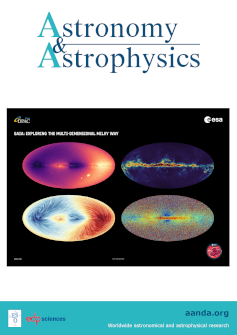用非线性无力场外推法推进对太阳黑子半影形成的理解
IF 5.8
2区 物理与天体物理
Q1 ASTRONOMY & ASTROPHYSICS
引用次数: 0
摘要
上下文。尽管人们对太阳黑子进行了广泛的研究,但半影形成背后的机制仍未完全了解。在这项工作中,我们从一种基于非线性无力场(NLFFF)外推的磁场分析的新方法来研究太阳黑子半影的形成过程,旨在确定驱动这一过程的关键参数。我们利用HMI/SDO数据对活动区域NOAA 12757在半影形成之前、期间和之后的发展进行了采样,计算了NLFFF外推。我们分析了由此产生的磁场倾角、磁场张力以及导点处电流密度的演变。分析的重点是太阳黑子的稳定部分,远离AR的相反极性。外推结果的分析表明:(1)外推磁力线脚点处实测的磁场倾角与反演结果吻合,证实了方法的一致性。(2)在半暗带形成之前,磁通量不断出现,在低层观察到的蛇形磁场概述了这一点。这些场出现后,进一步上升,形成由高回路构成的有源区域场拓扑结构。(3)新磁通量局部斑块的出现具有高磁张力和显著电流密度的特征,主要集中在原斑边界。当磁环继续上升时,磁张力和电流密度都逐渐消散。这种磁通量的出现发生在半影尚未形成和磁冠尚未发育的地区。(4)随着出射通量的增加,磁冠层随着下伏半影的形成而在斑周围形成并逐渐扩大。(5)随着半影和冠层的扩大,周围网场从最初靠近黑子边界的位置逐渐向外迁移,最大迁移距离约为9 Mm,这与以迁移的运动地物为脚点的蛇形磁场的上升提供了黑子核心磁场与周围网场连连性的证据。这个案例研究提供了明确的证据,表明稳定半影的形成是由自下而上的方法产生的:在日冕中,蛇形磁场线不断出现并向上上升,在此期间,太阳黑子磁冠形成。本文章由计算机程序翻译,如有差异,请以英文原文为准。
Advancing understanding of sunspot penumbra formation with non-linear force-free field extrapolations
Context. Although sunspots have been extensively studied, the mechanism behind the formation of penumbrae is still not fully understood.Aims. In this work, we investigate the process of sunspot penumbrae formation from a novel approach based on the analysis of magnetic fields from non-linear force-free field (NLFFF) extrapolations aiming to identifying the key parameters driving this process.Methods. We calculate NLFFF extrapolations from HMI/SDO data sampling the development of the active region NOAA 12757 before, during, and after penumbra formation. We analyse the resulting magnetic field inclination, magnetic field tension, and the current density evolution in the leading spot. The analysis focuses on the stable part of the sunspot, away from the AR opposite polarity.Results. The analysis of the extrapolations has revealed that: (1) the magnetic field inclination measured at the footpoints of the extrapolated field lines agrees with the results inferred from inversions, confirming the consistency of the methodology. (2) Penumbra formation is preceded by the continuous emergence of magnetic flux as outlined by serpentine fields observed in the low layers. After emerging, these fields further rise shaping the active region field topology formed by high-lying loops. (3) The emergence of local patches of new flux is characterised by high magnetic tension and significant current densities, primarily concentrated at the protospot boundary. Both the magnetic tension and current densities gradually dissipate as the magnetic loops continue to rise. This flux emergence occurs in regions where the penumbra is not yet formed and the magnetic canopy is not yet developed. (4) With the increase of emerged flux, a magnetic canopy develops and gradually expands around the spot in unison with the forming underlying penumbra. (5) As the penumbra and canopy expand, the surrounding network field, initially present close to the spot boundary, gradually migrates outward, reaching a maximum distance of about 9 Mm. This and the rise of serpentine fields, footpointed by migrating moving magnetic features provide evidence of the connectivity between the sunspot’s core magnetic field and the surrounding network field.Conclusions. This case study provides clear evidence that the formation of stable penumbra results from a bottom-up approach: the continuous emergence and upward rise of serpentine field lines into the corona during which a sunspot magnetic canopy develops.
求助全文
通过发布文献求助,成功后即可免费获取论文全文。
去求助
来源期刊

Astronomy & Astrophysics
地学天文-天文与天体物理
CiteScore
10.20
自引率
27.70%
发文量
2105
审稿时长
1-2 weeks
期刊介绍:
Astronomy & Astrophysics is an international Journal that publishes papers on all aspects of astronomy and astrophysics (theoretical, observational, and instrumental) independently of the techniques used to obtain the results.
 求助内容:
求助内容: 应助结果提醒方式:
应助结果提醒方式:


